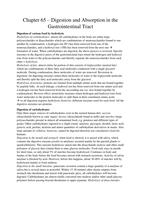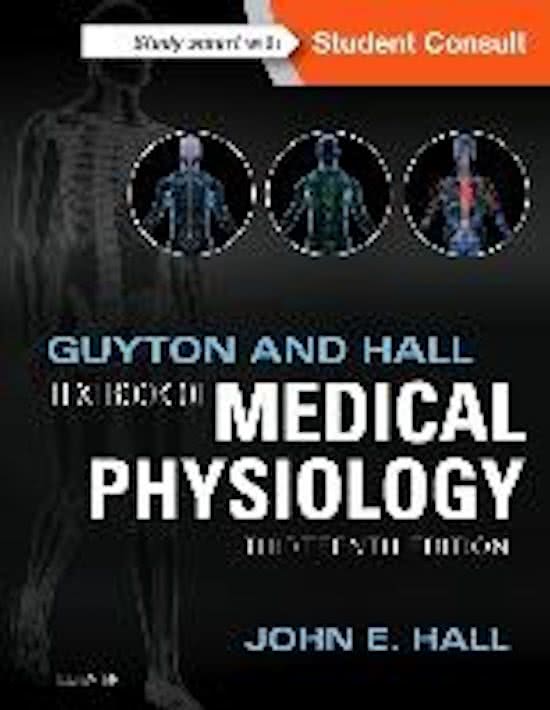Chapter 65 – Digestion and Absorption in the
Gastrointestinal Tract
Digestion of various food by hydrolysis
Hydrolysis of carbohydrates: almost all carbohydrates in the body are either large
polysaccharides or disaccharides which are combinations of monosaccharides bound to one
another by condensation: a hydrogen ion (H+) has been removed from one of the
monosaccharides, and a hydroxyl ion (-OH) has been removed from the next one
formation of water. When carbohydrates are digested, the above process is reversed. Specific
enzymes in the digestive juices of the gastrointestinal tract return the hydrogen and hydroxyl
ions from water to the polysaccharides and thereby separate the monosaccharides from each
other = hydrolysis.
Hydrolysis of fats: almost entire fat portion of diet consists of triglycerides (neutral fats)
which are combinations of three fatty acid molecules condensed with a single glycerol
molecule. During condensation, three molecules of water are removed. Reversion in
digestion: fat-digesting enzymes return three molecules of water to the triglyceride molecule,
and thereby split the fatty acid molecules away from the glycerol.
Hydrolysis of proteins: proteins are formed from multiple amino acids that are bound together
by peptide links. At each linkage, a hydroxyl ion has been removed from one amino acid and
a hydrogen ion has been removed from the succeeding one (so: also bound together by
condensation). Reverse effect: proteolytic enzymes return hydrogen and hydroxyl ions from
water molecules to the protein molecules to split them in their constituent amino acids.
so all digestion requires hydrolysis, however, different enzymes used for each food. All the
digestive enzymes are proteins.
Digestion of carbohydrates
Only three major sources of carbohydrates exist in the normal human diet: sucrose
(disaccharide known as cane sugar), lactose (disaccharide found in milk) and starches (large
polysaccharides present in almost all nonanimal food, e.g. potatoes and different types of
grain). Other carbohydrates ingested to a slight extent: amylose, glycogen, alcohol, lactic acid,
pyruvic acid, pectins, dextrins and minor quantities of carbohydrate derivatives in meats. Also
large amount of cellulose, however, cannot be digested therefore not considered a food for
humans.
Digestion in the mouth and stomach: when food is chewed, it is mixed with saliva, which
contains the digestive enzyme ptyalin (ɑ-amylase) secreted mainly by the parotid glands (=
speekselklieren). This enzyme hydrolyses starch into the disaccharide maltose and other small
polymers of glycose that contain three to nine glucose molecules. Food only stays in mouth
for short time, so only about 5% of starches become hydrolysed. Continues in body and
fundus of the body before the food becomes mixed with stomach secretions. Activity of salvia
amylase is blocked by acid. However, before this happens, about 30-40% of starches will by
hydrolysed mainly to form maltose.
Digestion in the small intestine: pancreatic secretion contain a large quantity of ɑ-amylase of
saliva but is several times as powerful. Within 15-30 minutes after chyme empties from
stomach into duodenum and mixed with pancreatic juice, all carbohydrates will become
digested. Carbohydrates are almost totally converted into maltose and/or other small glucose
polymers before passing beyond duodenum or upper jejunum. Hydrolysis of disaccharides






